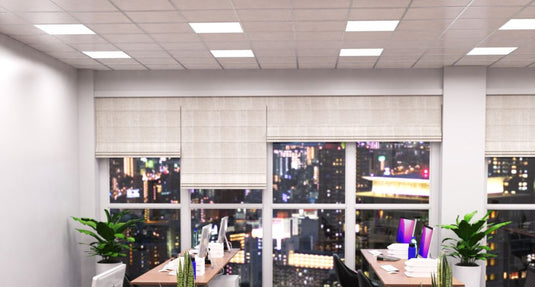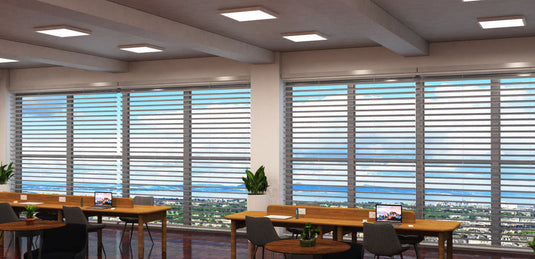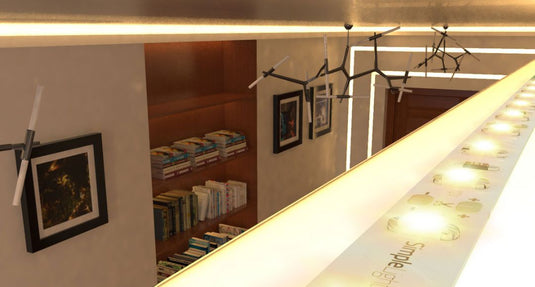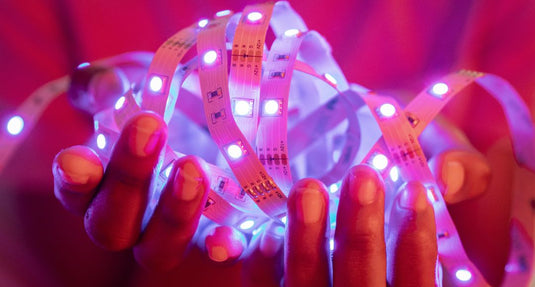LED panel lights are a series of combined components that provide an evenly lit panel of light. It’s really easy to find LED panels in a variety of shapes and sizes, which is why they prove so popular.
Any form of LED lighting is more beneficial for the environment and helps reduce electricity bills by 80%. LED panel lights are energy efficient and a staple lighting structure in commercial settings.
We’ve put together a guide for LED panels, breaking down everything you need to consider before buying them.
What Are LED Panel Lights?
LED panel lights are an eco-friendly alternative to conventional lighting. Panel lights work by slotting into a place where a tile would sit within grid ceilings. Panel lights are made relatively thin to help them slide into place accurately.
Recessed and suspended grid ceilings usually have fluorescent ceiling lights, which can add to electric bills and have to be replaced more frequently. The great thing about LED panel lights is that they do a better job of lighting up a big space and have a longer life span.
If you’re after a smooth, flawless wall of bright illumination without noticeable bulbs on show, LED panel lights are the perfect option. For indoor use only, LED panel lights cover larger areas of space efficiently.
Benefits Of LED Panel Lights
The main benefits of installing LED panel lights into your commercial space are that they’re ecologically friendly, durable, long-lasting with an extended lifespan, energy efficient and have low UV emissions.
More people are attempting to incorporate eco-friendly products into both their life and workspace. If trying to do your part for the planet is something you’re passionate about, then installing LED lighting will be a great first step in the right direction.
With a life expectancy of around 100,000 hours, LED panel lights last longer than incandescent light bulbs. LED panel lights' long life span means fewer light structures end up in landfill, which is one of the reasons that make them good for the environment.
Due to lasting for such a prolonged amount of time, LED lights are incredibly energy efficient and cost-effective. Because all LED lights last for years, you won’t have to worry about frequent replacement and electricity consumption costs.
Where Will You Find LED Panel Lights?
The most common places that have LED panel lights installed are offices, schools and supermarkets. Panel lights make great office lighting, as well as schools and supermarkets. This is because compared to a regular-sized LED light bulb, panels cover larger areas of space - perfect for large buildings or places that require a lot of light.
Another reason why businesses use LED panel lights is because of their simplicity and basic style. For many commercial spaces, the decor isn’t the main priority, meaning most business owners opt for various panel light structures over fancy lighting.
Differences Between LED Panel Lights And Downlights
Both downlights and panel lights are widely used within an array of different industries, but what exactly is the difference between the two? Let’s go through the similarities and differences.
LED Panel Lights
Used mostly in public areas and commercial buildings, LED panels are made from very thin optical grade cell cast acrylic sheet, with LED strip lights integrated inside, covered with diffusion film and a reflector.
Because LED panel lights are so thin, they’re the ideal lighting choice for shallow ceiling grids and stay as flat as the ceiling was before installations, making them blend in seamlessly.
Due to the large size variations of LED panel lights, they help employees see their surroundings clearer. Having the right amount of distributed light also reduces the chances of eye fatigue and headaches, which can be seen as a bonus in the workplace.
LED Downlights
LED downlights are commonly used for home lighting. You’ll find different styles of downlights in most kitchens, bathrooms and other living spaces. Downlights create a clean look and help illuminate rooms efficiently, similar to panel lights.
As discussed, LED downlights are often used in home environments and are installed to help highlight key areas instead of illuminating much larger spaces, which panel lights do a great job of.
Downlights are put in rooms that have other light fixtures dotted around to help amplify as much light as possible, for example, floor lamps or LED wall lights. Additional lighting isn’t needed when your in the presence of panel lights as they do the job on their own.
Although LED downlights aren’t too noticeable, you would need more depending on the size of your space - this could make them become less discreet and make people feel overcrowded.
Ways To Dim Panel Lights
Dimming panel lights can help create an ambience throughout your space and gives you controllability over how bright you want a certain space to be. The two main methods you can use to dim your LED panel lights are main dimming and low-voltage dimming.
Mostly used in places of residence where you’ll find a wall dimmer to control the lights, the method of mains dimming functions by altering the electrical signals to the main source of power, making it turn off every few seconds.
The process of mains dimming is ultimately just signalling being postponed, which later forces the panels to dim.
The method of low-voltage dimming is used if you have an LED driver. Electronic messages are sent to the driver, which controls the dimming of your lights. Low-voltage dimming is a much more popular, simpler process.
Panel Lights At LED Supplier
At LED Supplier, we have a wide range of panel lights that have been designed to replace standard fluorescent panels. All our panel lights are made with a lightweight aluminium frame, helping prevent light leakage.
Each one of our LED panel lights has up to 4,800 lumens, along with additional features such as frosted covers. We know how overwhelming it can be when there's so much of one product on the market, so trust us when we say that our LED panel lights are the best option to go for.
We’re proud to say that we have a collection of top-quality LED panel lights available in various shapes, sizes and colour temperatures.




